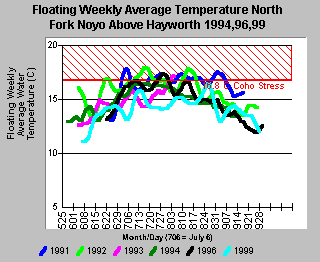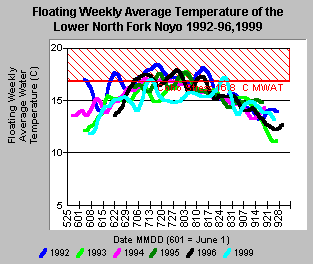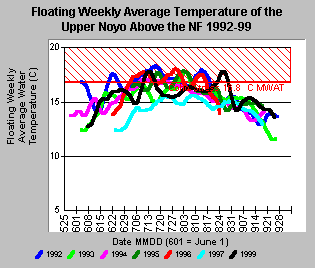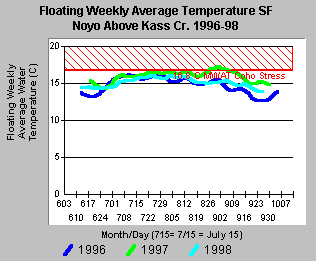Bibliography Background About KRIS
Hypothesis #3: Coho salmon production is limited by high water temperature in the Noyo River.
Support for hypothesis from the literature
Two recent studies conducted in northern California found that coho salmon were at extremely low abundance or absent in streams where the weekly average water temperature exceeded 16.80 Celsius one or more times during the season (Welsh et al., in press; Hines and Ambrose, 1998). Welsh et al. (in press) measured stream temperatures in the Mattole River and its tributaries while Hines and Ambrose (1998) studied numerous streams in the holdings of the Georgia Pacific Company, including tributaries of the Noyo River. Welsh et al. (in press) called the maximum of all floating weekly average temperatures the maximum weekly average temperature or MWAT. This is not to be confused with the temperature stress threshold for salmonid species described by Armor (1990). For more information on tolerance of coho and other Pacific salmon species, please see the Temperature background page.
From Noyo Data
No current studies of Noyo River temperature were made available to the IFR team. However, available data show that water temperatures at many Noyo River sites exceed the 16.80 Celsius threshold recognized as the limit of habitable temperatures for coho salmon by Welsh et al (in press) and Hines and Ambrose (1998). Fish data from the Mendocino Redwood Company generally confirm that coho are at very low levels or absent from streams that exceed this threshold. CDFG surveys and downstream migrant trapping indicate that coho are present at higher levels in the upper South Fork, North Fork of the South Fork and Parlin Creek where lower water temperatures exist. A potential confounding factor with higher South Fork abundance is that some CDFG supplementation of coho takes place.
Source Topics: The charts below are derived from the Topics listed here. Check these Topics in the KRIS database to see the information in context and to access the InfoLinks and Metadata.
(NF) Temperature: Floating Weekly Average NF Noyo Above Hayworth
(NF) Temperature: Floating Weekly Average Lower North Fork Above Main Noyo
(UN) Temperature: Floating Weekly Average Upper Noyo Above North Fork
(SF) Temperature: Floating Weekly Average SF Noyo Above Kass 1996-98
 |
 |
|---|---|
| The floating weekly average water temperature of the North Fork Noyo River above Hayworth Creek was above the 16.8 degrees C water temperature threshold for coho stress in 1991, 1992, 1993 and 1996. The water temperatures in 1994 and 1999 were cooler and the floating weekly average did not exceed 16.8 degrees C. The 16.8 degree C stress threshold was chosen based on Welsh et al. (in review) and Hines and Ambrose (1998). Data provided by the Mendocino Redwood Company. | The floating weekly average water temperature of the North Fork Noyo River at its convergence with the mainstem Noyo River at Northspur was above the 16.8 degrees C water temperature threshold for coho stress in all years measured. The duration and magnitude of exceedence varies between years. The 16.8 degree C stress threshold was chosen based on Welsh et al. (in review) and Hines and Ambrose (1998). Data provided by the Mendocino Redwood Company. |
 |
 |
|---|---|
| The floating weekly average water temperature of the mainstem Noyo River above its convergence with the North Fork Noyo River at Northspur was above the 16.8 degrees C water temperature threshold for coho stress in all years measured except 1997. The duration and magnitude of exceedence varies between years. The 16.8 degree C stress threshold was chosen based on Welsh et al. (in review) and Hines and Ambrose (1998). Data provided by the Mendocino Redwood Company. | In 1996 and 1998, the floating weekly average of the South Fork Noyo River at the boundary of Jackson Demonstration State Forest did not exceed the threshold for coho stress of 16.8 degrees C described by Welsh et al (in review) and Hines and Ambrose (1998). Water temperatures were elevated in late August and early September in 1997 and the threshold was exceeded. |
Alternative Hypotheses
Inland tributaries of the Noyo River were always warm and coho are low for other reasons.
Historical information on temperature from CDFG reports is strictly anecdotal, as only hand held thermometer readings were recorded, and there is little ability to gauge the range of stream temperatures at that time. Therefore, this hypothesis is impossible to test.
Monitoring Trends to Support or Refute the Hypothesis
While this hypothesis has been supported by field data in the Noyo Basin (Hines and Ambrose, 1998; MRC, CDFG and JDSF raw fish and temperature data), it could be further explored with more field studies to confirm or refute the relationship.
References
Armour, C.L. 1991. Guidance for evaluating and recommending temperature regimes to protect fish. U.S. Fish and Wildlife Service. Fort Collins. Biological Report 90(22). 13 p.
Hines, D.H. and J.M. Ambrose. 1998. Evaluation of Stream Temperature Thresholds Based on Coho Salmon (Oncorhynchus kisutch) Presence and Absence in Managed Forest Lands in Coastal Mendocino County, California. Georgia Pacific Corporation, Ft. Bragg, CA. 14 p plus Appendices.
Welsh, H.H., G.R. Hodgson, M.F. Roche, B.C. Harvey. (In review). Distribution of Juvenile Coho Salmon (Oncorhynchus kisutch) in Relation to Water Temperature in Tributaries of a Northern California Watershed: Determining Management Thresholds for an Impaired Cold-water Adapted Fauna. In review for publication in the North American Journal of Fisheries Management. U.S.D.A. Forest Service, Redwood Sciences Laboratory, Arcata, CA. 22 p.